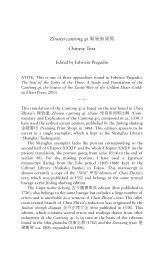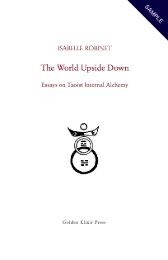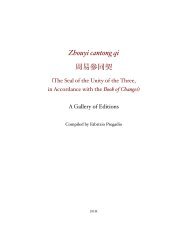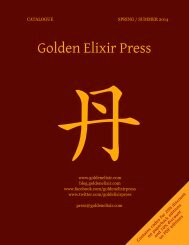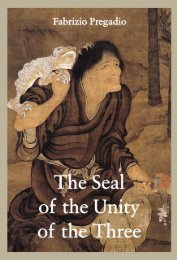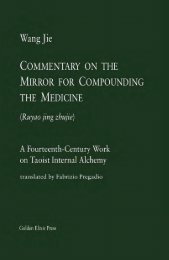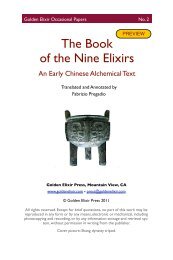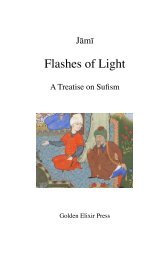The Seal of the Unity of the Three â Vol. 2 - The Golden Elixir
The Seal of the Unity of the Three â Vol. 2 - The Golden Elixir
The Seal of the Unity of the Three â Vol. 2 - The Golden Elixir
- No tags were found...
You also want an ePaper? Increase the reach of your titles
YUMPU automatically turns print PDFs into web optimized ePapers that Google loves.
4. <strong>The</strong> Ancient Text and Its Commentaries 187<br />
—————————————————————————————————————————<br />
cannot be deemed to be a “forgery” in <strong>the</strong> common sense <strong>of</strong> <strong>the</strong> term.<br />
Not only does <strong>the</strong> text, despite <strong>the</strong> different arrangement, include<br />
virtually <strong>the</strong> whole Cantong qi, with <strong>the</strong> omission <strong>of</strong> only a few verses<br />
and without any addition; but no one without a solid knowledge <strong>of</strong><br />
<strong>the</strong> standard version <strong>of</strong> <strong>the</strong> Cantong qi, and <strong>of</strong> its doctrinal principles,<br />
could have fabricated a work <strong>of</strong> this nature. In <strong>the</strong> arrangement <strong>of</strong> <strong>the</strong><br />
Ancient Text, <strong>the</strong> four- and five-character verses are not reproduced in<br />
<strong>the</strong> same sequence as in <strong>the</strong> standard version; while this is <strong>the</strong> only<br />
major difference at <strong>the</strong> textual level, in <strong>the</strong> new arrangement <strong>the</strong><br />
discourse <strong>of</strong> Cantong qi, its threefold set <strong>of</strong> subjects, and its “mirrored”<br />
portions reveal a much clearer pattern.<br />
<strong>The</strong> account <strong>of</strong> <strong>the</strong> composition <strong>of</strong> <strong>the</strong> Ancient Text includes all<br />
three authors traditionally deemed to have been involved in <strong>the</strong> creation<br />
<strong>of</strong> <strong>the</strong> standard version—and this is <strong>the</strong> main reason why several<br />
commentators, for whom Wei Boyang could only be <strong>the</strong> single author<br />
<strong>of</strong> <strong>the</strong> Cantong qi, rejected <strong>the</strong> Ancient Text as a whole. 7 According to<br />
<strong>the</strong> new version, Wei Boyang wrote <strong>the</strong> “Canon”; Xu Congshi 徐 從 事<br />
(whom <strong>the</strong> Ancient Text exegetes regularly identify as Xu Jingxiu 徐<br />
景 休 , as Yu Yan had already indicated) contributed a “Commentary”;<br />
and Chunyu Shutong 淳 于 叔 通 added a final section, entitled “<strong>Three</strong><br />
Categories” (again following Yu Yan’s suggestion). 8 <strong>The</strong> format <strong>of</strong> <strong>the</strong><br />
text is, on <strong>the</strong> o<strong>the</strong>r hand, entirely different, with each <strong>of</strong> <strong>the</strong> three<br />
authors being attributed one <strong>of</strong> its main parts:<br />
1. “Canon” (“Jingwen” 經 文 ), in verses <strong>of</strong> four characters, deemed<br />
Ancient Text, this time mainly to point out that it originated with Du Yicheng<br />
and not with Yang Shen, who did nothing beyond republishing it under his<br />
own name. Two o<strong>the</strong>r essays in <strong>the</strong> Xu Wei ji are concerned with <strong>the</strong> Cantong<br />
qi, respectively found in 16.471–72 and 16.473–78.<br />
7<br />
Despite <strong>the</strong>ir criticism, <strong>the</strong> Ancient Text inspired <strong>the</strong> new, inventive<br />
formats <strong>of</strong> <strong>the</strong> standard version <strong>of</strong> <strong>the</strong> Cantong qi contained in <strong>the</strong> commentaries<br />
by Xu Wei (ca. 1570), Li Guangdi (ca. 1700), and Li Shixu (1823).<br />
Moreover, <strong>the</strong> views <strong>of</strong> Zhu Yuanyu (1669) and Dong Dening (1787) on <strong>the</strong><br />
three main subjects <strong>of</strong> <strong>the</strong> Cantong qi are also clearly inspired by those <strong>of</strong> <strong>the</strong><br />
Ancient Text. On <strong>the</strong>se commentaries see <strong>the</strong> previou chapter.<br />
8<br />
<strong>The</strong> earliest extant source that records <strong>the</strong> name Xu Jingxiu appears to<br />
be <strong>the</strong> Danlun juezhi xinjian (CT 935), 8a, an alchemical text related to <strong>the</strong><br />
Cantong qi dating from ca. 900 (<strong>the</strong> same passage is also found in <strong>the</strong> Huandan<br />
zhouhou jue, CT 915, 2.4a, composed in <strong>the</strong> tenth or <strong>the</strong> eleventh<br />
century). Yu Yan mentions Xu Jingxiu in Zhouyi cantong qi fahui, 9.16a. For<br />
his views on <strong>the</strong> “<strong>Three</strong> Categories,” see below, p. 209.<br />
Visit <strong>the</strong> Web page on this book • www.goldenelixir.com



